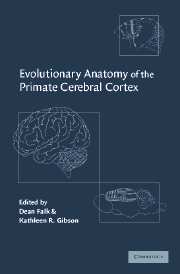Book contents
- Frontmatter
- Contents
- List of contributors
- Preface
- Prologue: Size matters and function counts
- Part I The evolution of brain size
- Introduction to Part I
- 1 Encephalization and its developmental structure: how many ways can a brain get big?
- 2 Neocortical expansion and elaboration during primate evolution: a view from neuroembryology
- 3 In defense of the Expensive Tissue Hypothesis
- 4 Bigger is better: primate brain size in relationship to cognition
- 5 The evolution of sex differences in primate brains
- 6 Brain evolution in hominids: are we at the end of the road?
- Part II Neurological substrates of species-specific adaptations
- Epilogue: The study of primate brain evolution: where do we go from here?
- Index
1 - Encephalization and its developmental structure: how many ways can a brain get big?
Published online by Cambridge University Press: 07 October 2011
- Frontmatter
- Contents
- List of contributors
- Preface
- Prologue: Size matters and function counts
- Part I The evolution of brain size
- Introduction to Part I
- 1 Encephalization and its developmental structure: how many ways can a brain get big?
- 2 Neocortical expansion and elaboration during primate evolution: a view from neuroembryology
- 3 In defense of the Expensive Tissue Hypothesis
- 4 Bigger is better: primate brain size in relationship to cognition
- 5 The evolution of sex differences in primate brains
- 6 Brain evolution in hominids: are we at the end of the road?
- Part II Neurological substrates of species-specific adaptations
- Epilogue: The study of primate brain evolution: where do we go from here?
- Index
Summary
Harry Jerison argued in his Evolution of the Brain and Intelligence that the initial enlargement of the brain of ancestral mammals resulted from refinement of the sensory processes of audition and olfaction, improving adaptation to life in nocturnal niches (Jerison, 1973). Every relationship and transition hypothesized in this statement is an intriguing subject for investigation. Twenty-five years later, challenged by Jerison's vision, we (and he) have learned a great deal about the variation in the structure of the brains of extant mammals and of those mammals represented in the fossil record (Jerison, 1991). Concurrently, the explosion of knowledge in neuroscience has profoundly changed our view of the organization, localization and development of functional systems in the brain. We can now make much better sense of variation in neural structure in terms of behavioral function. In particular, appreciation of how functions can be distributed over multiple brain components is coming to replace our initial single structure-single function models. Furthermore, we can now extend Jerison's initial evolutionary question to ask how brain changes come about developmentally.
In this review, we first examine the extent to which specific structures in the brain may be the targets of selection, or whether change occurs at the level of interconnected functional systems, other organizational units, or at the most global level of brain size. After we have described where variation occurs in the brains of extant mammals, and at which level or levels this variation occurs, our job as developmental neurobiologists is to describe how development produces these differences.
- Type
- Chapter
- Information
- Evolutionary Anatomy of the Primate Cerebral Cortex , pp. 14 - 29Publisher: Cambridge University PressPrint publication year: 2001
- 6
- Cited by



